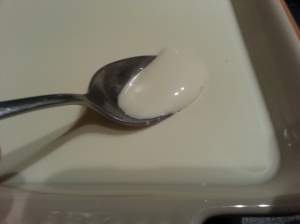As I promised in my last post, I have a second cheese recipe for you that uses a traditionally-made British cheese. Harvey & Brockless sent me a whole loads of excellent cheeses and other goodies, and tucked in there was probably my favourite British blue cheese, Isle of Wight Blue:
‘Established in 2006 by mother and son Julie and Richard Hodgson, Isle of Wight Cheese Co. flagship blue is soft and creamy with a bluey green natural rind and blue veins.’
It’s strong, yet mellow and very creamy. Nothing like a Stilton at all (I love a good Stilton too, of course).
This is exactly the sort of cheese Professor Peter J. Atkins and I were talking about in my podcast episode about the British cheese industry, and how there is a resurgence in traditional styles and methods: softer cheeses made in small batches in small farms – before the behemoth that is Cheddar came along!
This cheese, because of its blue cheese flavour, low acidity and smooth consistency, is perfect to make into an ice cream. Cheese ice creams used to be popular, hitting a peak in the Regency period: indeed, the Prince Regent himself tucked into Parmesan cheese ice cream. My ice cream, like Prince George’s, is sweetened, but it is not over-sweet. It’s very simple to make – a case of mixing soft cheese into some cream and sugar. A curdy, hard or crumbly cheese would not work here.
I’ve combined it with a dessert classic: pears poached in red wine. There’s a recipe in Forme of Cury for it, so it really does have quite the vintage. The poaching wine is sweet and spiced and is reduced to a delicious, tart and slightly fiery spooning sauce. On the side: a nice digestive biscuit.
This is a well tried-and-tested recipe: it’s popped up on restaurant and pop-up restaurant menus in the past, but I originally made it as part of The Telegraph Fabulous Foodie competition all the way back in 2015. It was judged by none less than Xanthe Clay, John Gregory Smith and Jeremy Dixon and it took me to the grand final. So if you are still unsure as to whether you’ll like it, take it from them, not me, that it is good!
Give it a go, you won’t be sorry. Also, see below for an excellent way of using up left over ice cream and sauce.
Serves 4 to 6
For the ice cream:
1 x 225 g round of Isle of Wight Blue at room temperature
450 g double cream
1 ½ tbs icing sugar
In a bowl, break up the cheese as best you can and beat into it one third of the cream. You won’t be able to blend it in perfectly, but a little texture is no bad thing.
Sift the icing sugar with the reminder of the cream in a second bowl and whip until just slightly floppy, then fold into the cheese.
Freeze it in an ice cream churn if you have one. Alternatively, place in a tub, pop in the freezer and beat it with a small whisk every 20 to 30 minutes or so until it becomes too difficult; at that point you are done, and it can be left in the freezer until required. If you don’t want to freeze it, you can whip the cream a little more and use it like clotted cream.
For the pears:
4 to 6 unripe conference pears
500 ml red wine
100 g caster sugar
1 cinnamon stick
2 long peppers (or ¼ tsp black peppercorns)
¼ tsp ground ginger
Peel the pears, leaving the stalks intact. Slice the bottom so that the pear is able to stand up sturdily. If you have one, use a melon baller to remove the core from beneath.
Bruise the cinnamon stick and long pepper (or crack the peppercorns) and place in a pan with the wine and sugar. Put over a medium-low heat and stir to dissolve the sugar. Once dissolved, add the pears.
Bring to a simmer and cover the pan, turn down the heat and poach until tender. This will take around 20 minutes. The pears won’t be completely submerged, so to ensure an even colouring from the wine, turn them half way through cooking.
Remove the pears and set aside. They can be stored in the fridge for up to four days.
Now make the syrup: turn up the heat and bring the wine to the boil and let it reduce by around three-quarters or more, until viscous. Pour into a jug or jar and allow to cool.
To serve:
Remove the ice cream from the fridge around half an hour before you want to serve. Place a pear in the centre of a plate – it may need another trim at the bottom if it’s been in the fridge a day or two – and carefully spoon a couple of teaspoons of the syrup over the tip of the pear.
Place a biscuit next to the pear – I used a homemade digestive (post coming soon), but a hob-nob would also work very well – and place a scoop or quenelle of ice cream on top the biscuit.
Leftovers: there will probably be leftover ice cream and syrup, the latter of which keeps for weeks. Treat yourself to a very grown-up ice cream cookie sandwich using digestives instead of cookies, cheese ice cream instead of vanilla, and red wine syrup in place of raspberry sauce.



















































